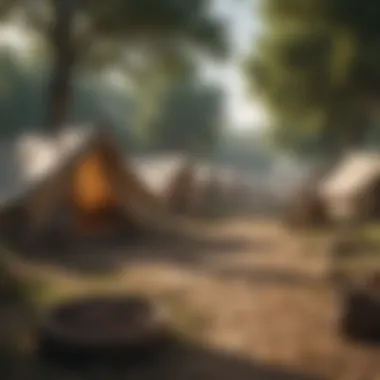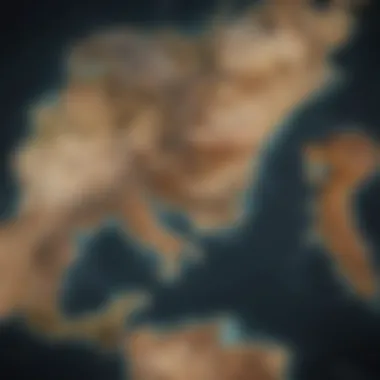Uncovering Your Romani Ancestry: A Comprehensive Guide


Intro
Tracing Romani ancestry requires an understanding of diverse approaches rooted in both cultural and historical contexts. This endeavor is not only about identifying lineage; it is about connecting with a rich heritage that spans centuries and continents. As many face questions relating to their identity, tools such as genealogical research, genetic testing, and cultural insights become essential in this exploration.
One must acknowledge the complexities of Romani history. The Romani people, often misunderstood, are a diverse group with various traditions, languages, and experiences. Understanding this background is crucial when embarking on the journey to uncovering Romani ancestry. This article aims to equip readers with the right methodologies and insights necessary to navigate the intricate pathways of their Romani heritage.
Methodology
Overview of research methods used
When seeking to determine Romani ancestry, multiple research methodologies prove effective. First, genealogical research remains foundational. Historically, Romani families weathered much upheaval, influencing how records were kept and maintained. Accessing birth, marriage, and death certificates can reveal invaluable information.
Moreover, oral histories play a critical role. Many Romani families retain stories that depict their past, preserving identity and connection. Engaging with older generations can provide nuanced details that formal records may lack.
Another approach includes community outreach. Connecting with Romani community organizations can prove beneficial in locating resources and individuals well-versed in family histories. These organizations often hold archives, photographs, and narratives that can further illuminate one's ancestry.
Data collection techniques
Data collection in the context of Romani ancestry encompasses both qualitative and quantitative methods. Quantitative data, such as census records, offers a structured way to trace lineage statistically.
Qualitative techniques hold equal, if not greater, importance. Collecting stories through interviews and visiting community events aids in understanding the richness of Romani culture and influences.
- Utilizing online databases: Websites like Ancestry.com or FamilySearch.org are useful in locating family trees and records that may connect to Romani ancestors.
- Connecting social media: Platforms such as Facebook and Reddit can provide groups focused on Romani ancestry. Here, individuals can share experiences, tips, and resources to facilitate their searches.
The quest to determine one's Romani ancestry is often layered with both challenges and rich discoveries. Understanding the right methodologies vastly improves the journey of uncovering one’s heritage.
Future Directions
Upcoming trends in research
The future of Romani ancestry research may heavily lean on technological advancements. Genetic testing, specifically through companies like 23andMe or AncestryDNA, can provide insight into specific ethnic backgrounds. As awareness increases regarding privacy and data management, new platforms may emerge to address these concerns while offering robust ancestry research options.
Areas requiring further investigation
Despite the work done in Romani studies, several areas still need attention.
- Historical documentation: There remains a significant gap in comprehensive documentation concerning Romani history, particularly in European contexts.
- Cultural representation: Further representation of Romani heritage in academic studies could bridge existing gaps in understanding.
Understanding Romani Ancestry
Understanding Romani ancestry is a vital component in the quest to uncover one's heritage. This exploration is not simply about establishing a genealogical connection. It involves embracing the depth of Romani history, culture, and identity. Recognizing the significance of this ancestry allows individuals to appreciate the rich traditions and resilience of the Romani people.
Many individuals seek their Romani ancestry for various reasons. Some might have felt a connection to Romani culture through familial stories or personal experiences. Others may wish to understand their cultural identity better, as the Romani experience is often marked by historical migrations, social challenges, and rich traditions.
Within this context, several key elements stand out when discussing Romani ancestry:
- Cultural Heritage: Romani ancestry encompasses a diverse tapestry of traditions, beliefs, and practices, enriching one's understanding of their own background.
- Historical Significance: The historical context of the Romani people's migration and settlement can shed light on current social and cultural dynamics.
- Language and Dialects: The distinct languages and dialects of Romani communities are vital in understanding their various identities and can provide clues about ancestry.
Engaging in this journey requires sensitivity and patience. Additionally, it demands an awareness of the complexities and challenges that may arise in researching this dynamic ancestry. These include varying levels of documentation, differing historical narratives, and potential misinterpretations related to Romani culture.
"Exploring Romani ancestry is a pathway to identity, connection, and understanding, transcending mere genealogical structure."


Thus, this section serves as a foundation for the discussions that follow, setting the stage for a deeper look into the Overview of Romani Culture, Historical Migration Patterns, and the Romani Languages and Dialects that shape the experience of individuals seeking to reclaim their heritage.
Genealogical Research Techniques
Genealogical research techniques play a crucial role in identifying one's Romani ancestry. They comprise methods and tools that can help individuals piece together their family history and heritage. Understanding these techniques allows for a methodical approach to tracing ancestry, combining documentation gathering with the use of historical records.
Building Your Family Tree
Gathering Documentation
Gathering documentation is vital for constructing a family tree. This involves collecting various forms of paperwork that provide evidence of family relationships. Document types may include birth certificates, marriage licenses, and immigration papers. The key characteristic of gathering documentation is its reliance on physical evidence, making it a solid foundation for genealogical research. It is a popular choice for individuals seeking Romani ancestry due to the concrete data it offers.
The unique feature of this method lies in its accuracy. Documentation provides clear information that can be verified. However, challenges can arise, such as missing records or difficulties in accessing certain archives. Despite these potential obstacles, the benefits of documented proof outweigh the disadvantages. Organized documentation can greatly enhance the understanding of family connections.
Interviewing Family Members
Interviewing family members can be an insightful method for learning about ancestry. This technique involves asking relatives about their backgrounds, stories, and any known connections to Romani heritage. A significant aspect of this method is the rich oral history that often accompanies these narratives, which may not be recorded elsewhere.
The main advantage of interviewing relatives is the personal perspective it provides. Each family story can open doors to new aspects of ancestry exploration. However, this technique also has its limitations. The reliability of memory can vary, and some family histories may be romanticized or exaggerated. Nonetheless, interviewing family members remains a valuable practice for piecing together ancestry narratives.
Using Historical Records
Historical records serve as a backbone for genealogical research. They offer insights into past lives through various documentation from earlier periods. Key types of these records include census data and church registries, which can reveal family connections and movements.
Census Data
Census data is a fundamental historical record widely used in genealogical studies. It provides population statistics at regular intervals, detailing who lived in a particular area at a given time. The essential characteristic of census data is that it encompasses a broad range of personal information, such as names, ages, and family arrangements. This makes it an effective and beneficial tool for those seeking to trace their Romani lineage.
One unique feature of census data is its accessibility. Many census records have been digitized, making them available to a wider audience. However, interviewing findings might complement these details, as sometimes census data can contain inaccuracies or be lacking in context. Despite potential gaps, census data remains a powerful asset in genealogy.
Church Registries
Church registries represent another important source of historical records. These documents store information on births, marriages, and deaths within religious communities. The key advantage of church registries lies in their specificity, often recording intimate and detailed data not found in secular documents.
This method is particularly beneficial for those researching Romani ancestry due to the close-knit ties within certain communities. However, access to church records can be limited based on the denomination or location. Furthermore, records may have been lost or damaged over time. Despite these challenges, using church registries offers unique insights that can greatly enrich the understanding of one’s family background.
The Role of DNA Testing
DNA testing has emerged as a pivotal tool in uncovering Romani ancestry. It offers insights that traditional genealogical methods may not provide. By exploring genetic markers, we can connect to distant relatives and comprehend the broader tapestry of our heritage. This scientific approach not only augments familial records but also reveals connections to specific populations that might have remained obscured through conventional means.
Types of Genetic Tests
Y-DNA Testing
Y-DNA testing focuses exclusively on the Y chromosome, which is passed father to son. This testing is particularly useful for tracking paternal lines. One of the key characteristics of Y-DNA testing is its ability to reveal deep ancestry from male ancestry, often going back thousands of years. This makes it a popular choice for individuals looking to trace their direct paternal lineage.
A unique feature of Y-DNA testing is its haplogroup assignment, which can indicate geographical origins and migrations of male ancestors. While it provides valuable insights, a disadvantage is that only males can undergo this testing, limiting its universal applicability in uncovering Romani ancestry for everyone.
mtDNA Testing
mtDNA testing, or mitochondrial DNA testing, focuses on the maternal line. This testing analyzes specific markers in mitochondrial DNA, which is passed down from a mother to her children. A major characteristic of mtDNA testing is its emphasis on maternal lineage, allowing individuals to trace their ancestry through their mothers. This choice is valuable for those interested in understanding their maternal roots within the Romani culture.


The unique advantage of mtDNA testing is that it is accessible to both males and females. However, the limitation lies in its inability to provide information about paternal ancestry, which means it cannot yield a complete picture of one’s lineage.
Autosomal Testing
Autosomal testing examines chromosomes inherited from both parents, combining the DNA from all ancestral lines. This form of testing facilitates a broader ancestry assessment and can provide estimates regarding ethnic backgrounds. A notable characteristic is its capacity to connect individuals with relatives across several generations, making it a favored option for those seeking comprehensive ancestry information.
Autosomal testing offers significant advantages, such as the ability to uncover diverse branches of a family tree. However, one disadvantage is that the results may be less specific regarding deep ancestry compared to Y-DNA and mtDNA tests, which could be crucial for understanding Romani roots.
Interpreting DNA Results
Interpreting the results of DNA testing is a crucial step in the journey of discovering Romani ancestry. Understanding what the data signifies can provide deeper insights into one’s heritage.
Ethnic Ancestry Estimates
Ethnic ancestry estimates offer information about the geographical regions corresponding to an individual’s genetic makeup. This feature allows people to see potential connections to Romani communities and cultures. Such estimates can highlight the diversity in one’s heritage and help build a more informative context around their ancestry. An essential benefit is the opportunity to gain understanding beyond immediate family connections, potentially revealing ties to broader ethnic groups. Yet, the accuracy of these estimates can vary, and they are often guidelines rather than definitive conclusions.
Genetic Match Insights
Genetic match insights involve identifying relatives based on shared DNA segments. This process can connect individuals with living relatives and facilitate further genealogical research. It is beneficial for building a network of family connections, which can enhance the understanding of one’s lineage. A unique aspect is that it may uncover relationships that were previously unknown, enriching one's sense of heritage. However, the complexity of interpreting these matches can be overwhelming, requiring careful consideration and potentially additional research to clarify relationships.
DNA testing provides unique insights into your ancestry, but it is vital to approach results thoughtfully and in conjunction with other research methods.
Cultural and Community Aspects
Understanding the cultural and community aspects of Romani ancestry is crucial. These elements not only provide context but also enhance the process of uncovering one's heritage. By engaging with cultural practices and community networks, individuals can find deeper connections to their ancestry. This section will discuss the significance of oral traditions and the importance of participating in Romani communities.
Importance of Oral History
Oral history plays a vital role in Romani culture. This method of storytelling allows for the transmission of knowledge and traditions from generation to generation. Families often share tales that reflect their unique experiences, helping individuals uncover hidden aspects of their lineage. By listening to these narratives, one may find critical information about ancestors, migration patterns, and cultural practices. Oral history often fills gaps that formal records cannot.
Moreover, oral history emphasizes the significance of personal connection and identity. These stories provide emotional ties to the past, reinforcing a sense of belonging. Many Romani people believe in the power of their heritage, and sharing these stories further solidifies this principle. Therefore, making an effort to capture and document oral histories is an important step in the research process for those exploring their Romani ancestry.
Engagement with Romani Communities
Engagement with Romani communities can greatly enrich your understanding of your heritage. By connecting with others who share similar backgrounds, individuals can access a wealth of knowledge.
Local Cultural Events
Local cultural events serve as an excellent opportunity for individuals to immerse themselves in Romani traditions. These events typically showcase music, dance, and art originating from various Romani groups. Participation in these events allows individuals to witness their culture firsthand and meet others who share their background.
These events are also beneficial for networking. Attendees often share stories and insights that can aid individuals in their genealogical research. However, while they foster community, these events can sometimes vary in authenticity, depending on the organizers. It is essential to approach them with an understanding of how cultural representation can change.
Romani Organizations
Romani organizations are dedicated to preserving and promoting Romani culture and rights. These groups often provide resources for individuals seeking to learn more about their ancestry. They may offer workshops, access to records, and support networks that can be invaluable for genealogical research.
One notable aspect of these organizations is their commitment to advocacy. They work to raise awareness about Romani issues on local and global platforms. Engaging with these organizations can not only help you learn about your heritage but can also contribute to larger efforts that benefit the Romani community as a whole. However, it's important to navigate these networks sensitively and acknowledge their challenges within broader societal contexts.
"Ancestry is a journey, and connection to culture can guide that path."
Potential Challenges in Research


Understanding the challenges involved in researching Romani ancestry is vital for anyone attempting to navigate this complex landscape. The multifaceted nature of Romani heritage, intertwined with historical injustices and cultural nuances, presents unique considerations that researchers must confront. Addressing these challenges not only serves to refine one's approach but also enhances the overall quality of ancestry research.
Limitations of Historical Records
Historical records can often be fragmented or incomplete, which makes tracing an individual's Romani roots particularly difficult. Many Romani communities have faced social exclusion, leading to a lack of documentation in formal historical records. For instance, census data may omit Romani individuals altogether or misrepresent their identity due to cultural biases.
Additionally, official records may have been destroyed or lost over time, particularly during tumultuous periods. These gaps in documentation can hinder accurate lineage tracing and create barriers for those investigating their genealogical background.
To mitigate this issue, researchers can take a multifaceted approach, utilizing alternative sources. Oral histories, local archives, and community records can fill in the gaps left by formal documentation. By embracing a wider range of resources, researchers can navigate these limitations more effectively.
Misinterpretations and Stereotypes
Another significant hurdle in Romani ancestry research is the prevalence of misinterpretations and stereotypes surrounding Romani culture. These misconceptions may stem from prevalent societal narratives that often portray Romani people in a negative light. Misconceptions can lead to hindered research or erroneous conclusions about one's ancestry.
Stereotypes often suggest a homogenous Romani identity, disregarding the diverse languages and cultures within the Romani community. This can skew understanding and result in careless assumptions about individual lineage. Therefore, it is crucial for researchers to approach their efforts with cultural sensitivity and a commitment to understanding the rich tapestry of Romani identities.
Researchers should rely on verified sources and collaborate with experts in Romani studies to gain accurate perspectives. This collaboration not only enriches the research process but also fosters respect for the community being studied.
"Understanding the nuances of Romani identity requires more than mere data collection; it demands an appreciation for the cultural context that shapes each individual’s story."
Overall, being aware of these challenges allows for a more thoughtful approach to uncovering Romani ancestry. Acknowledging the limitations of historical records and confronting stereotypes is essential to conducting respectful and effective research.
Ethical Considerations
The exploration of one's Romani ancestry demands a careful approach to ethical considerations. It is crucial to foster respectful engagement with the Romani communities and the history tied to their culture. Individuals embarking on this genealogical journey must navigate the delicate balance between pursuing personal knowledge and honoring the cultural heritage of the Roma.
An essential aspect is cultural sensitivity in research. This involves recognizing and respecting the distinct traditions, beliefs, and practices of Romani people. Researchers should understand that Romani identity can be complex and multifaceted. Engaging with Romani communities offers insights and firsthand perspectives, enriching the understanding of one's heritage without reducing it to mere data points.
Moreover, it is beneficial to establish relationships with individuals within these communities. Such connections can lead to shared knowledge and mutual respect, promoting a more holistic understanding of Romani ancestry. Ethical considerations thus pave the way for richer experiences in family history research. They help preserve and value the heritage, rather than exploiting it.
In addition to cultural sensitivity, privacy concerns in genetic testing are another critical facet. Genetic testing can provide significant insights into ancestry but also raises questions regarding data security and personal information. When individuals submit their DNA to testing companies, there is an inherent risk involved regarding how this data is managed, stored, and potentially shared. Privacy in genetic testing must be taken seriously.
Potential buyers of genetic test kits should carefully read the terms of service described by companies, like AncestryDNA and 23andMe, to understand how their genetic information will be used. It is wise to ask questions and be informed about whether data is anonymized or if it can be accessed by third parties. Some individuals might experience discomfort knowing their DNA could be used for purposes they did not intend. Understanding these aspects is paramount when embarking on genealogical research that incorporates DNA testing, especially when the search involves historically marginalized communities.
Ultimately, being mindful of ethical considerations enhances one’s journey into discovering Romani ancestry. It fosters authentic connections with cultural heritage and elevates the integrity of genealogical research.
End
The conclusion of this article serves as a critical reflection on the multifaceted journey of uncovering Romani ancestry. Understanding one’s Romani roots offers insight into a culture rich in history and tradition. This exploration has several important elements that individuals should consider.
First, it synthesizes key data gathered through genealogical research and DNA testing, emphasizing the importance of combining both methodologies. Many people find that combining personal stories from family interviews with concrete evidence from historical records provides a fuller picture of their ancestry. This synergy can lead to more profound personal connections and a better understanding of identity within the broader Romani community.
Second, the discussion highlights the ethical considerations involved in ancestry research, which can help guide individuals in their quest with respect and sensitivity. Individuals eager to learn more about their lineage should carry an awareness of the potential impacts of their research on living communities and adhere to practices that honor cultural integrity.
Lastly, individuals are encouraged not merely to stop at the discovery but to further engage with their Romani heritage. By doing so, families can keep alive the rich traditions, community ties, and stories that shape their identity. In summary, the conclusions drawn here extend beyond mere facts; they encapsulate the essence of what it means to connect with one's past and illustrate the path forward for those interested in Romani ancestry.
Summation of Key Points
- The journey of discovering Romani ancestry incorporates both genealogical research and genetic testing.
- It is crucial to be culturally sensitive while conducting research to avoid perpetuating stereotypes.
- Engaging actively with Romani communities can deepen understanding and connections to heritage.
Encouragement for Further Exploration
Delving deeper into your Romani ancestry can be a profound and enlightening experience. Find local Romani organizations or cultural events to immerse yourself further. Collaboration with experts and community elders can bring invaluable perspectives.
For those interested in genealogical methods, consider exploring materials from reputable resources such as Wikipedia and Britannica for expanded knowledge. Participate in discussions on platforms like Reddit to find support and share experiences.
As you embark on this exploration, keep an open mind and a ready spirit to embrace the complexities of your heritage. The rewards of this journey extend beyond mere identification; they enrich personal narratives and foster connections with a historically rich group.







